The early immigrants from Hawaii and the homeland who came to the mainland U.S. first arrived in San Francisco. From there, they scattered to find work, primarily in cities adjacent to California. In California, they mainly engaged in farming or fruit picking. In Northern California, they cultivated rice and radishes, while in Central and Southern California, they primarily focused on fruit farming.
The cities in California where early Korean immigrants primarily resided or were active include the following:
Northern California
- Colusa: 100 miles north of San Francisco
- Manteca: 70 miles east of San Francisco
- Marysville: 30 miles north of Sacramento
- Taylorsville: 100 miles north of Sacramento
- Tracy: 60 miles east of San Francisco
- Turlock: 100 miles east of San Francisco
- Redwood City: 20 miles southeast of San Francisco
- Sacramento: 90 miles northeast of San Francisco
- Sausalito: 5 miles north of San Francisco
- Sunnyvale: 35 miles southeast of San Francisco
- Stockton: 25 miles southwest of San Francisco
- Walnut Grove: 80 miles northeast of San Francisco
- Willows: 120 miles north of San Francisco
- Woodland: 90 miles northeast of San Francisco
Central California
- Delano: 250 miles southeast of San Francisco
- Dinuba: 190 miles southeast of San Francisco
- Hanford: 200 miles southeast of San Francisco
- Lompoc: 120 miles northwest of Los Angeles
- Fresno: 150 miles southeast of San Francisco
- Reedley: 180 miles southeast of San Francisco
- Visalia: 180 miles southeast of San Francisco
Southern California
- Claremont: 25 miles east of Los Angeles
- Santa Ana: 25 miles southeast of Los Angeles
- Upland: 120 miles northwest of Los Angeles
- Redlands: 60 miles east of Los Angeles
- Riverside: 65 miles east of Los Angeles
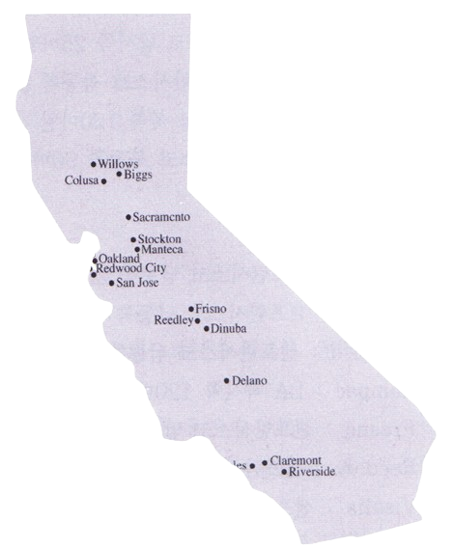
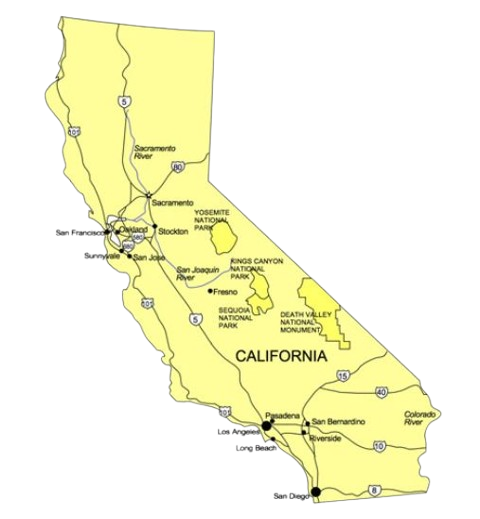
Ridley and Dinuba are small towns located about 200 miles south of San Francisco. They are also situated 200 miles north of Los Angeles, making them central to California, hence the name Central California. The distance between these two towns is 6 miles. Currently, Ridley has a population of only 1,218, but during the early immigration period, it was a significant city for fruit agriculture in California. Dinuba, on the other hand, has become a center for fruit agriculture from that time to the present, with a population of 170,000 and over 35 fruit processing farms and wineries.
Ridley and Dinuba are busy agricultural areas where labor is in demand year-round. In the summer, workers pick grapes, peaches, and watermelons, while in spring, fall, and winter, they prepare for the next year’s farming. Starting from 1909, early immigrant workers gathered in Central California after passing through Hawaii and San Francisco. When the March 1st Movement occurred in the homeland in 1919, the Korean Women’s Patriotic Association in this region began holding annual March 1st commemorative parades on L. St. in Dinuba starting in 1920, raising national consciousness by marching with the Korean flag. Central California was an important city for early immigration, and the Shinhan Minbo newspaper dedicated significant coverage to the Central California region.
This document summarizes key findings from research papers by Dr. Cha Man-jae, a professor at California State University, Fresno, as well as reports from the Shinhan Minbo and other literature to explore the immigration history of Central California.
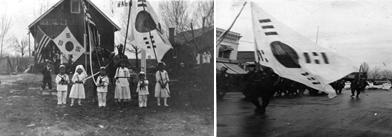
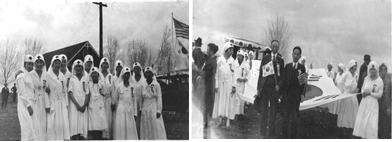
Early Immigration in Central California
In Ridley and Dinuba, there are 189 tombstones of Korean ancestors, with names and dates inscribed in Korean, English, or Chinese.
The earliest tombstone discovered dates back to 1906. Given that these tombstones were found in both Ridley and Dinuba, it can be inferred that Koreans had already been living in the area prior to that time. The most recent tombstone dates to 1994. Although it is relatively recent, it is still a burial site for early immigrants. Dr. Cha Man-jae stated that there are a total of 189 tombstones for early immigrants.
When categorized by surname, there are 59 Kim (31%), 30 Lee (16%), and 17 Park (9%). In 1960, 10 people died, which was the highest number in a single year, and from 1960 to 1969, 45 people died. Considering the average lifespan of 60 to 70 years, these individuals likely worked in farming during the 1920s and 1930s.
In 1938, there were records of 11 Korean families living in Ridley.
Most Korean families were large, with 4 to 5 children, according to the memories of local residents who have lived in Ridley for generations. It is also estimated that two-thirds of the 189 individuals lived and died single. These individuals were likely single when they immigrated and never found spouses. Some records indicate that at one time, the Korean population in Ridley, including temporary residents and second-generation immigrants, approached 500, but they were more likely to work in fruit processing facilities formed near nearby cities rather than in primary agriculture.
According to testimonies from Koreans who lived in Ridley during the 1940s, there was an annual picnic where nearby Koreans gathered. It is said that at least over 100 people attended, making it one of the most popular and largest gatherings among Koreans at that time.
Social Conditions Documented in Newspapers
- September 30, 1908: Lee Jae-soo, living in Fresno, Central California, was welcomed, and everyone was moved by his activities over the five years since he immigrated.
- August 31, 1916: Peach packing and grape picking—”This year’s grapes in Dinuba are the best in nearly ten years, creating many job opportunities. Come to the labor dispatch office near town.” Labor dispatcher Kim Byung-kyu.
- June 14, 1917: The Dinuba local council raised $250 to establish the Dinuba Korean Language School, enrolling 11 students from the 4th and dividing them into three classes for Korean language instruction.
- September 6, 1917: The Dinuba local council gathered compatriots for the grape harvest season, and when the central president, Ahn Chang-ho, and the local president, Lee Dae-wi, visited on August 29, the day of national humiliation, over 200 compatriots gathered in a grand assembly.
- December 7, 1919: In Dinuba, Lee Soon-ki and Lee Beom-young were the main figures in forming the Labor Society Advancement Party. They later published a magazine called “Dongmu” and supported the Overseas Korean Committee.
- December 3, 1942: Dinuba Korean Flower Car—First Prize in the Armistice Parade. On November 11, the day of the armistice of World War I, a grand parade was held in various cities across the U.S. to promote patriotic sentiment, and in Dinuba, a beautifully decorated flower car titled “The Constitution of America—This is the Value of Battle” received the top prize amidst the warm welcome of thousands of spectators. This top prize was awarded for four consecutive years, greatly achieving the promotion of Koreans.
- December 19, 1946: The Delano local council held its annual meeting at Park Chung-seop’s inn on December 9.
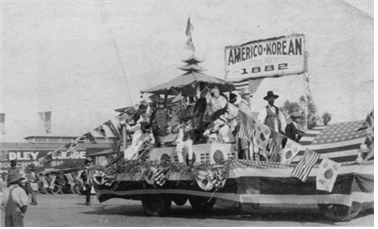
Economy
When the Koreans first arrived in Ridley, jobs were not readily available, and they faced intense competition for employment from other ethnic groups. At that time, the social atmosphere was one of disregard for Asians. Moreover, almost all early immigrant Koreans were unable to speak English.
Naturally, Koreans ended up working in agriculture, which required little language or technical skills. Between 1920 and 1930, it is estimated that there were over 30 Korean-owned labor housing buildings in Ridley, indicating that Koreans were entering self-employment related to agricultural labor. Records also indicate that there were three hotels owned by Koreans in Dinuba at that time.
The work on the farm was mostly contract-based. During the farming season, the employment period was set, and the wage was around 25 cents per hour. At that time, living expenses were said to be between 10 and 15 dollars a month. If one were to work 8 hours a day like today, the daily income would be 2 dollars. The labor was hard, but considering the cost of living at the time, it wasn’t difficult enough to cause extreme hardship. However, when World War II broke out and the U.S. entered the war, the monthly living expenses surged to over 25 dollars, so it can be assumed that there were some difficulties during that period.
However, disputes between Korean workers and employers also occurred. The local newspaper, The Dinuba Sentinel, reported an incident on August 25, 1910, titled “Korean Gets Beaten.” The report stated, “There was a dispute over wages between a Korean named Y.S. Kim and his employer J.T. Godman. When Kim insulted Godman, Godman threw a farming tool at Kim’s head.” This incident escalated into a lawsuit and resonated throughout the community.
When discussing the early immigrant economy in Ridley and Dinuba, Kim Hyung-soon and Kim Ho are indispensable figures. They established a company called the Kim Brothers Company, engaging in orcharding, seedling business, and plant packaging. They particularly gained a patent for the fuzzless peach, known as “nectarine,” generating substantial income. While it is difficult to accurately gauge the wealth of these two individuals, it is said that they were already known as millionaires in the 1950s.
The Kim Brothers Company employed about 200 people, and during the fruit harvest season, the number of workers more than doubled. Additionally, these two men provided housing for those workers who did not have accommodations.
Meanwhile, Kim Young-jung and Song Cheol, who worked at the company while studying, established a wholesale business called “The K&S Jobber,” connecting fruits from the Kim Brothers’ farm to retailers. They succeeded in this business, but Kim Young-jung left to study at Harvard University on the East Coast. Song Cheol continued to focus on the business, eventually renaming it “Song’s Packing Company,” which his three sons have continued to operate under the same name to this day.
It goes without saying that these two companies became the main economic driving forces of the Korean community in Ridley and Dinuba. Furthermore, Song Cheol supported the Dongji Association, helping Lee Seung-man in the independence movement, while Kim Ho and Kim Hyung-soon supported the National Association in the independence movement.
Additionally, Kim Ho financially assisted Kim Won-yong in writing “The History of Koreans in America for 50 Years.” This book, published in Ridley in 1959 (513 pages), is an invaluable historical record of Koreans in America that cannot be measured in monetary terms. If wealthy individuals like Kim Ho had not taken an interest in such matters, the precious historical facts of our early immigration would have been forever obscured.
As news of the Kim Brothers Company spread, Korean students from across the U.S. flocked to work there in the 1950s and 1960s. In 1962, the Kim Brothers Company established a scholarship foundation to support economically disadvantaged but outstanding students.
At that time, the center of social activities for Koreans was the church. The church served as a venue for not only church members but also for most gatherings of Koreans, including birthday parties, weddings, and funerals, and was a cornerstone of the Korean community.
On December 14, 1919, a meeting was established to include local Koreans comprehensively, with Jo So-ang elected as the first president. At its peak, membership reached over 350. This organization disbanded in 1923 but once published a newsletter called “Dongji.”
When the March 1st Movement occurred in the homeland in 1919, the Korean Women’s Patriotic Association in this region held annual March 1st commemorative ceremonies in Dinuba, proudly raising the Korean flag. They also initiated a movement to boycott Japanese soy sauce as part of their anti-Japanese activities, spreading this initiative throughout the Korean community in America.
Economic Activities Reflected in Korean Media
◈ July 18, 1913: Prosperity in Grape Picking in Dinuba / Pastor Min Chan-ho comes to the fields to evangelize hundreds of compatriots. Peaches will be picked around July 20, and grapes around August 15. Those who are coming to work should visit the place where Mr. Kang Byeong-rim used to stay. – Advertisement by innkeeper Lim Seong-taek
◈ August 31, 1916: Peach Packing and Grape Picking – This year, the grapes in Dinuba are the best they have been in nearly 10 years, and there is plenty of work available. Come to the labor dispatch office near the town. – Labor dispatcher Kim Byeong-kyu, Weddle Place R. F. D. No Box 90 B Dinuba
◈ February 12, 1942: Kim Yong-ho is looking for people to work on grape pruning at a farm in Dinuba.
◈ November 21, 1946: Mr. Han Si-dae, who is staying in Delano, recently opened a lunch and ice cream shop called “Pulbang” on Main St. with a white classmate, and it has been quite popular with many customers and promising prospects. – Delano Correspondence
◈ June 10, 1948: Reconstruction of the Kim Brothers Company Warehouse in Central California
The warehouse of the Kim Brothers Company in Ridley was damaged by fire last summer and has recently been rebuilt. A completion ceremony is planned to be held soon, and friends are invited to celebrate.
◈ June 17, 1948: Completion of the Reconstruction of the Kim Brothers Company
As part of the Korean-American business community, the Kim Brothers Company in Ridley, Central California, has invested over $70,000 in building a large packing house, which is nearly complete, and is expected to start packing in early July.
Businesses in Central California
Plant Supply Company
On September 20, 1920, Kim Ho, Oh Chung-guk, Kim Tak, Ahn Sang-hak, Kim Il-hwan, Song Heon-joo, and Jeon Seong-yong organized a company in Ridley. They set a total capital of 20,000andraised20,000 and raised 20,000andraised100 weekly for 200 shares, engaging in the business of supplying various vegetables and fruits.
Kim Brothers Company (Charles & Harry Kim)
Founded in 1921 by Kim Ho (Charles Kim) and Kim Hyung-soon (Harry Kim), this company was established by entrepreneurs who settled in the Ridley area for rural living. They engaged in the transportation of agricultural products and served as a wholesale intermediary, while also running a nursery for residential gardens. They developed the nectarine peach and patented it for sale across the United States.
The brand names “Lee Grand” and “Sun Grand” became very popular, generating significant profits. The Kim Brothers Company reportedly owned over 500 acres across six locations, with 400,000infruitpackingfacilitiesand400,000 in fruit packing facilities and 400,000infruitpackingfacilitiesand100,000 in nursery facilities. Their annual revenue exceeded $1 million, making it one of the most successful businesses among early Korean immigrants.
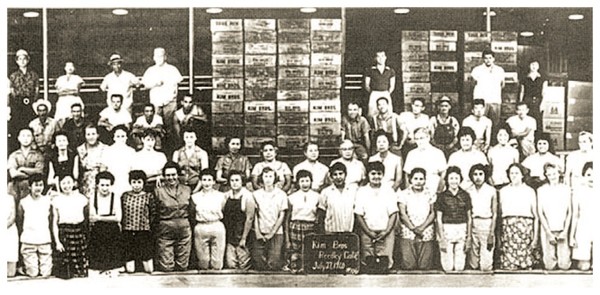
Han Brothers Company
In the Delano area, Han Si-dae organized a company with a 400-acre grape farm. His children also became interested in agriculture, and at one point, their assets reached $480,000.
Churches in Central California
Dinuba Korean Presbyterian Church (1912–1958)
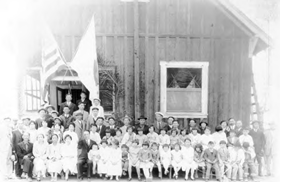
In February 1930, the Korean congregation in Dinuba reached out to the Presbyterian Mission Board, leading to the dispatch of Pastor Raplin to establish a Korean mission, with Evangelist Lee Chi-wan leading the worship services.
The Dinuba Korean Presbyterian Church, along with the Reedley Korean Presbyterian Church, served as a spiritual home for Korean farm laborers who lived by picking grapes and peaches from the 1910s to the late 1950s.
Despite their exhaustion from labor, they found comfort in attending church. It was a place where those who lived with the sorrow of losing their homeland could meet on Sundays to encourage and support one another. They willingly contributed a portion of their hard-earned money to the independence fund and the National Association, and they were proactive in educating the second generation in the Korean language.
During the summer and fall, they were busy picking grapes, peaches, and watermelons, and in the remaining seasons, they were occupied with planting, nurturing, and preparing for the next harvest. Starting in 1909, Koreans came to this area via Hawaii, and many would drink heavily after their exhausting labor, while gambling, which began as a pastime, grew larger.
Concerned about this, the Koreans in Dinuba recognized the need for a church and established one with the help of the Northern Presbyterian Church. On August 5 of that year, the historic “Korean Women’s Patriotic Association” was launched. On October 15, 1912, they purchased land to build a chapel, which was dedicated on December 23.
From August 22, 1913, they held a week-long revival meeting, reportedly attracting over 100 attendees each session. On March 8, 1917, they built a separate pastor’s office, and the church continued to develop its structure. On March 2, 1918, the women’s organization in Dinuba, the Shinhan Women’s Association, was formed. On February 25, 1920, the church was officially upgraded from a “mission” to a Presbyterian church, marking the establishment of a formal church for Koreans.
From 1920 onward, they held annual March 1st Independence Day parades on L St., raising national consciousness. At one point, laborers from Ridley also attended services, increasing the number of congregants, but by the 1950s, most Koreans in the area had moved elsewhere, making it difficult to maintain the church.
The church closed on February 4, 1958, with a peak membership of 150 and a low of only 15. Today, the Dinuba Police Department building stands in its place. The church’s pastors included Lee Chi-wan, Hong Chi-beom, Raplin, Han Seung-kwon, Song Byeong-soon, Lee Sal-eum, Koo Wang-do, Kim Hyung-tae, Kim Hyung-il, and Choi Joong-seob. The Dinuba Korean Presbyterian Church served as a spiritual home for Korean laborers engaged primarily in grape and peach farming from 1912 until 1958.
Reedley Korean Presbyterian Church
In February 1919, as the number of Korean residents in the Reedley area increased, a church was established. The exact address is 1408 1/2 J St., at the intersection of 14th St. The Koreans designated the home of Jeon Seong-yong as a place of worship and invited Methodist evangelist Lim Jeong-gu to lead services, later using the Kim Brothers Company’s house as a chapel.
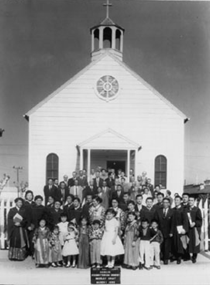
In the 1920s, as 400 to 500 Koreans lived in Dinuba and Reedley, the Southern Methodist Mission Board upgraded the Korean worship gatherings to a Korean Methodist Church on March 26, 1922. However, in June 1936, the issue of shrine worship in Korean Methodist churches in Korea affected even the Reedley Methodist Church. At that time, Korean residents in Central California were actively engaged in the boycott of Japanese soy sauce and fervently sending patriotic donations for the independence movement. The congregation was outraged by the acceptance of shrine worship by the church in the homeland and resolved to withdraw from the Methodist denomination.
The church transitioned from the Methodist denomination to the Presbyterian denomination and was renamed the Reedley Korean Presbyterian Church. By October 1938, as the number of congregants reached over 50, the need for a proper chapel became apparent. Kim Ho and Kim Hyung-soon donated land on J St. for the church, and the congregation collectively raised funds to build their own church.
They also established a “Koryo School” within the church to provide Korean language and traditional dance education for the second generation, aiding in the settlement of immigrants. The church also built a dormitory for struggling Koreans. At its peak, the congregation numbered over 60, while at its lowest, it was around 22.
This area, known for its farms growing grapes, peaches, oranges, apples, plums, and watermelons, had most of its congregants working as laborers on these farms. Nevertheless, they showed more enthusiasm for the independence movement than anywhere else, with the church always at the center of these activities. It served as a meeting place for children’s education, weddings, and other gatherings for Koreans.
After completing the church building, they held a dedication ceremony on March 1, 1939, inviting Dr. Payne, the general secretary of the Presbyterian headquarters, and officially joined the San Joaquin Presbytery on April 16, 1939, marking their first step as part of the American Presbyterian Church. On June 7, they held a ceremony for the establishment of the Korean Presbyterian Church, officially naming it the Reedley Korean Presbyterian Church. The financial support from the Kim Brothers Company greatly contributed to the church’s development. Pastors who served included Kwon Jong-heup, Ma Jun-heung, Lim Jeong-gu, Han Seok-won, Song Heon-young, Lee Sal-eum, Yoon Byeong-gu, Lee Gi-jun, Kim Jong-seong, Kim Hyung-il, and Choi Joong-seob.
While the Dinuba Presbyterian Church and the Reedley Korean Presbyterian Church shared a common goal for the liberation of their homeland, a sense of rivalry began to emerge after liberation. This was because many in the Dinuba area supported Lee Seung-man, while those in Reedley were primarily aligned with the National Association supporting Dosan.
In December 1952, the Reedley Korean Presbyterian Church, having built a parsonage on the church property, closed due to a decline in congregants as Koreans moved away. The church building remains, but it is now used by a different ethnic church. Founded in February 1919, this church had its own building by October 1938, thanks to the land donation from Kim Ho and Kim Hyung-soon and the collective fundraising efforts of the congregation.
Delano Korean Methodist Church
On February 10, 1930, the Koreans in Delano invited Pastor Han Seok-won to lead their first service. After contacting the Methodist Mission Board, they established the church on June 13 of that year, with Bishop David officiating. After Pastor Kim Tak was appointed on March 5, 1936, they received a closed church building in Stockton as a donation for $500. The congregation also raised funds to establish or renovate the chapel, and they held a dedication ceremony on September 6 of that year.
On October 1, 1954, they moved the chapel to Clinton St., reducing the size of the church, but the Korean population rapidly declined, leading to its closure in June 1958. At its peak, the congregation numbered over 70, while at its lowest, it was only about 10. Pastors who served included Han Seok-won, Kim Tak, Lee Gi-jun, Kim Hyung-il, and Kim Ha-tae.
Piablo Korean Methodist Church
On September 10, 1917, Koreans living in the Piablo area established a Methodist mission and set up a chapel inside a dormitory. Evangelist Woo Hong-tae served there but the mission was discontinued after two years.
Lompoc Presbyterian Church (1907–1918)
On February 27, 1913, Koreans living in the Lompoc area established a chapel in the camp of Kim Seong-o’s farm. The presbytery dispatched Pastor Raplin to establish a Korean mission. Evangelist Min Chan-ho served for five years before the mission was closed.
Schools in Central California
- Ridley: Established the Haedong Korean Language School on September 10, 1927, to teach the Korean language.
- Dinuba: Established the Koryo Academy on April 8, 1928.
- Delano: Established the Taegeuk School on July 14, 1930.
- Delano: According to the Shinhan Minbo on June 6, 1946, during the graduation ceremony held on May 28 at Delano Elementary School, among 98 students, 5 were Korean. Among them, Kim Tak’s daughter, Moon-hee (13), and Kim Seok-jun’s daughter, Janet (14), were selected as outstanding student speakers, receiving praise from an audience of over a thousand.
- June 14, 1917: The Dinuba local council raised $250 to establish the Dinuba Korean Language School, enrolling 11 students from the 4th and dividing them into three classes for Korean language instruction.
- September 6, 1917: The Dinuba local council gathered compatriots for the grape harvest season, and when the central president, Ahn Chang-ho, and the local president, Lee Dae-wi, visited on August 29, the day of national humiliation, over 200 compatriots gathered in a grand assembly.
- August 18, 1918: The Korean Student Friendship Association was formed in Dinuba.
- 1942 Graduates: Luther Han, Peter Kim, Junior Oh graduated from Central California Delnano High School. Gloria Baek graduated from Central California Bakersfield Junior College.
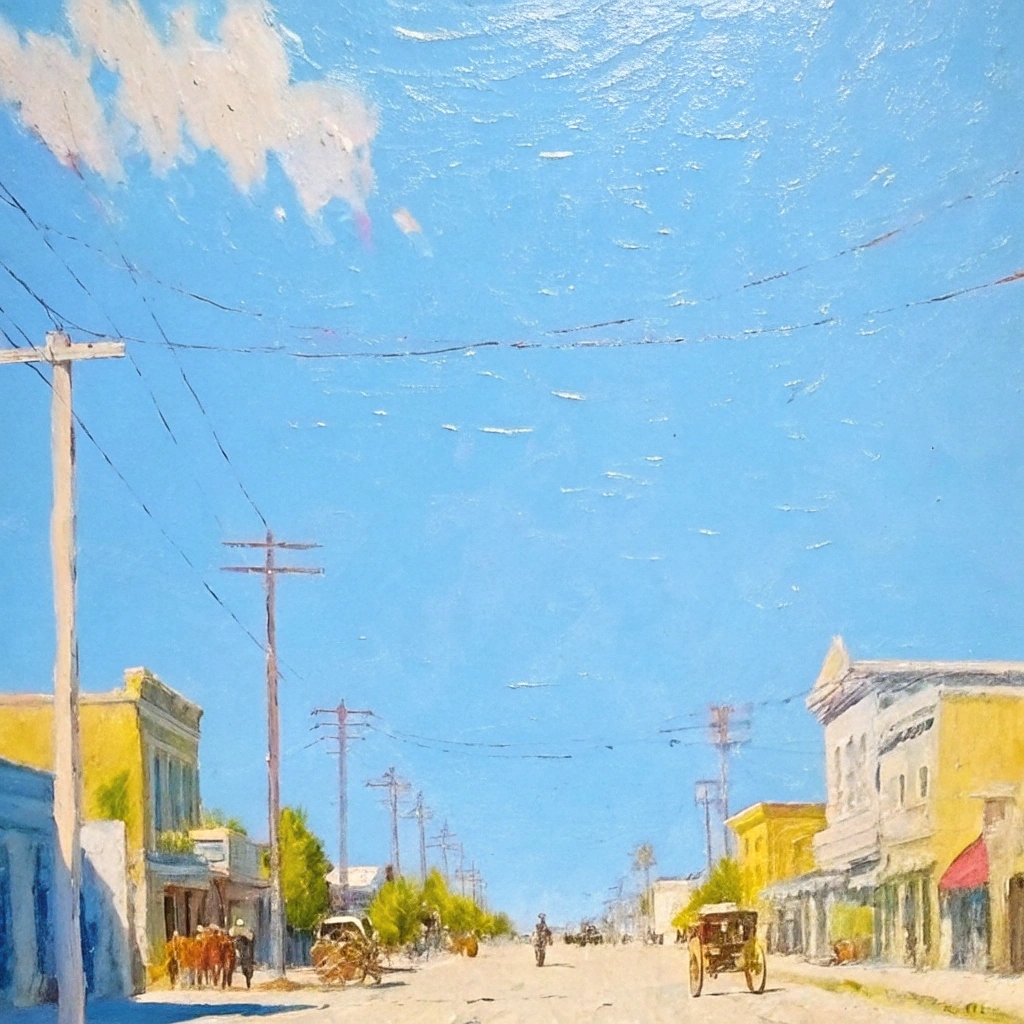
Leave a Reply